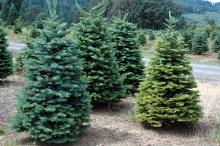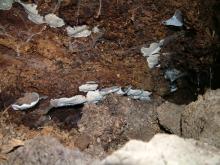See:
Fir, Douglas and True - Laminated Root Rot
Cause Heterobasidion occidentale, a fungus. This native soil pathogen is often in large old tree stumps. It can live several decades as a saprophyte on stumps and roots. Infection is mainly from airborne spores produced by conks on or in old stump hollows. Spores infect freshly cut stump surfaces or trunk wounds. Cut stumps are susceptible only for a short period of time. Infection spreads from stumps to roots of healthy seedlings or trees that contact infected wood. Root infections may lead to root and lower bole decay; the tree dies directly or as a result of windthrow. Trunk infections lead to stem decay. Bark beetles also often infest infected trees.
The disease can be found in forests, ornamental plantings, and Christmas tree plantations where true fir has been partially harvested. New trees planted between the stumps of old infected trees are especially likely to get the disease. More root disease has been found when land has been planted for the second or third time (rotation) to Christmas trees. Pockets of this disease increase in plantations where the disease goes unnoticed and/or untreated. It also can be a problem in stump-cultured Christmas trees, which are cut high and in which a lower branch is then trained into a new tree. Infected Christmas trees do not take up water well when displayed, which reduces their postharvest quality.
Host range of this fungus includes 150 conifer and angiosperm trees. The disease is especially troublesome on ponderosa and lodgepole pines in southern Oregon, often on drier sites, resulting in tree mortality. Also troublesome on grand and white fir of the Cascades and east side of Oregon. This fungus is also a serious wound decay pathogen and butt rotter especially in coastal spruce/hemlock forests and high elevation true fir stands. The disease can be found on Douglas-fir but is consider more of an oddity. Urea in an aqueous solution of 20% or higher has been effective as a fresh stump protectant on pine but more variable on spruce and other tree species.
Symptoms In the later stages of root infection, affected trees show crown yellowing and reduced terminal and lateral branch growth. These are general symptoms and can be confused with any other root rot problem. Infected roots may be covered by mycelium of the pathogen, but most often no mycelium or conks are present. Decayed wood may be laminated or stringy with black flecks. Seedlings can begin to die a few years after planting. Diseased trees may occur in pockets in the field.
There may be no aboveground symptoms before Christmas tree harvest. However, a dark staining of the older wood may be evident on the cut surface.
Cultural control
- Monitor for staining in the older wood of recently cut trees that may indicate a problem in one or more fields.
- Stumps should be excavated between rotations to prevent spread especially when the disease has been found within the plantation.
- Remove and destroy infected trees and root systems if possible.
- In mixed-species areas, favor resistant species such as cedar, pine, or hardwoods when planting, thinning, or harvesting. Nordmann fir also has been found to be resistant.
- Avoid wounding tree roots and trunks.
- The use of dirt to cover freshly cut stumps has been suggested but has only worked in 2 of 3 tests.
Chemical control Treat freshly cut stumps with a surface protectant. This is important in plantations that do not yet show evidence of the disease.
- Treating grape pruning wounds with sealants or paints has been effective when used within 24 hours of a pruning cut and may be useful in this system as well. These products include B-Lock, Spur Shield, or Vitiseal. See labels for details.
- Cellu-Treat at 1 lb/gal water.
Biological control
- Phlebiopsis gigantea (formerly Peniophora gigantea) has been effective on pine and spruce but is not easily available.
- Trichoderma spp. have been tried with positive results on stumps of a few tree species and are readily available.
References Woodward, S., Stenlid, J., and Karjalainen, R., and Huttermann, A. 1998. Heterobasidium annosum: Biology, Ecology, Impact and Control. New York: CAB International.
Dart, N.L., Chastagner, G.A., and Peever, T.L. 2007. Spread of Heterobasidion annosum in Christmas tree plantations of the United States Pacific Northwest. Phytopathology 97:551-556.



